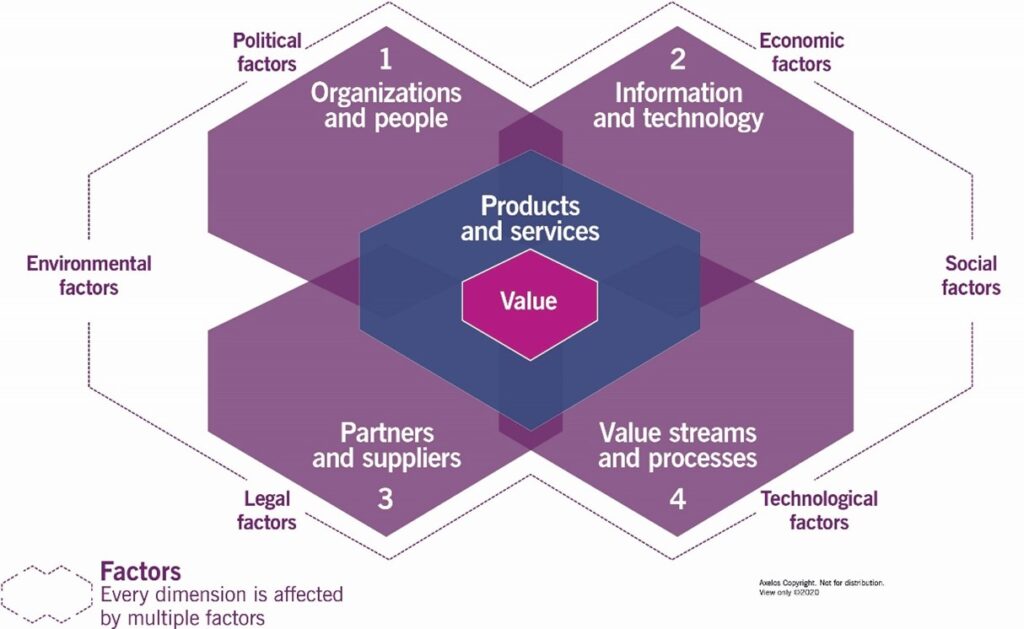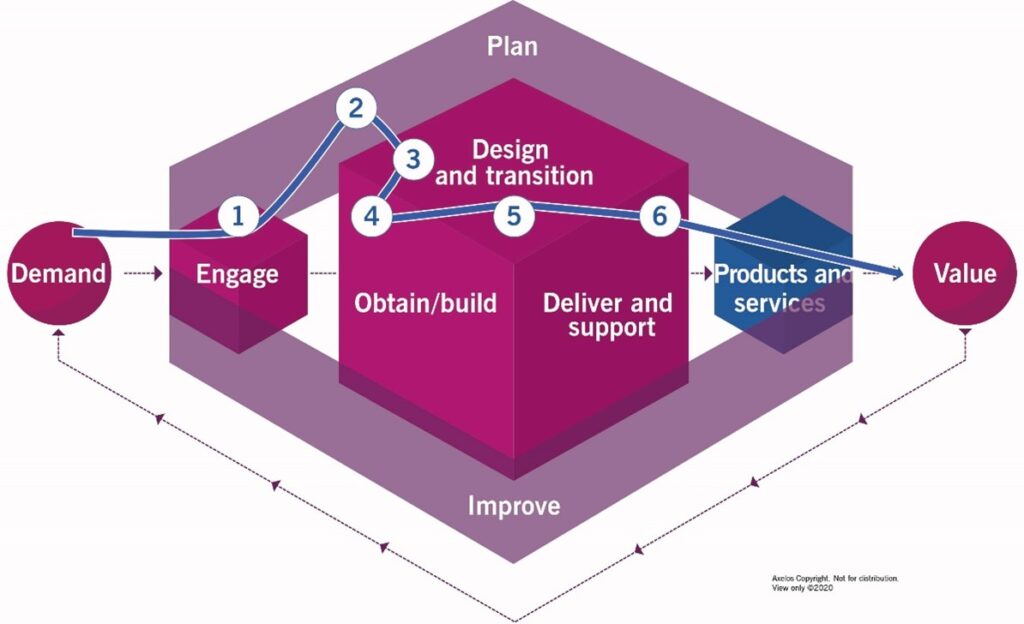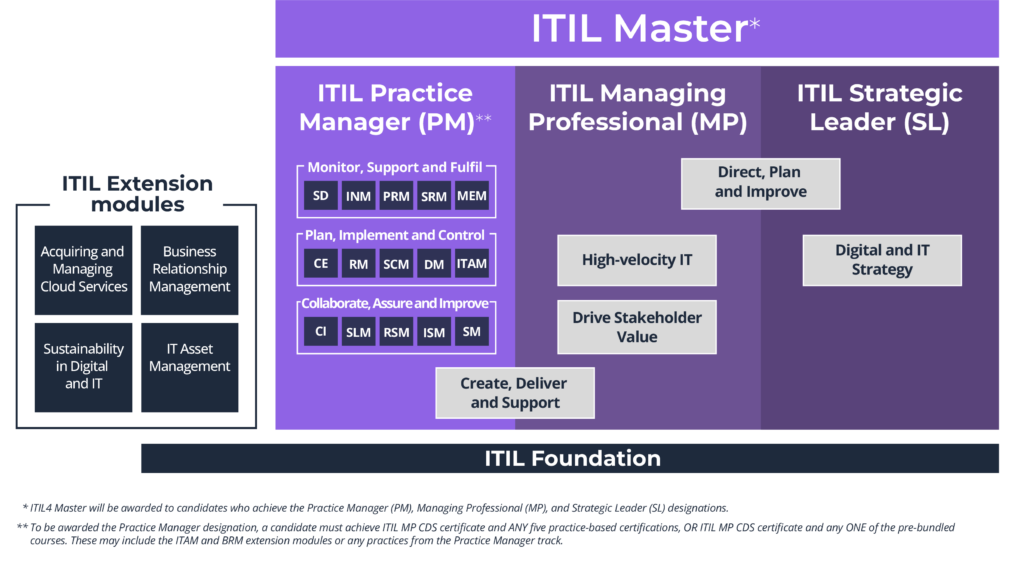SO, WHAT’S NEW & WHAT’S STAYED THE SAME
ITIL 4 was released in February 2019 and it’s not so much rising out of the ashes but more a natural evolution.
ITIL 4 has introduced numbers of improvements. Some are in recognition of changes in the way IT has evolved as organisations have focused on digital transformation and introduced new working methods such as DevOps and Agile developments alongside the migration of services to the various formats of cloud computing (Infrastructure, Platform or Software as a Service). Others are around more structure in the controls of the end-to-end life of both services and the relationships with key stakeholders.
WHAT’S NEW
The Service Value System
The Service Value System (SVS) outlines the components that need to work together to enable value creation from IT services. We can liken the Service Value System to a hexagonal onion. At the centre of the Service Value System is the Service Value Chain (SVC) which defines the activities in the creation and operation of the services.
At the centre of the Service Value System is the Service Value Chain (SVC) which defines the activities in the creation and operation of the services.
Surrounding the Service Value Chain are the 34 ITIL 4 Practices (new name for processes, more on this later) that are used across the Service Value Chain activities and Governance.
On the outside are Continual Improvement and the 7 Guiding Principles (adjusted from the 9 guiding principles introduced in the ITIL v3 Practitioner). As can be gathered from their name the Guiding Principles are there to guide an organisation in any circumstance.
Although detailed guidance for IT Governance can be found with COBIT, ITIL discusses the need for organisational structures, controls over priority setting for investment and expected behaviours.
To view upcoming ITIL 4 Foundation course dates please click here.
The 4 Dimensions
No, ITIL has not added time to height length and breadth. The four dimensions are a natural evolution of the old four ‘P’s of service design and are intended to provide a holistic approach to the creation and delivery of the services.
People has moved onto Organisations and People and this highlights the needs for good organisation structures, leadership and clear roles and responsibilities.
Products has evolved into Information and Technology recognising that an effective IT organisation needs the benefits of digital transformation in the way it works just as much as any other business area. Included here is also the element of keeping information and knowledge secure and the recognition that information is not always digital.
Partners has become Partners and Suppliers and focusses on the relationship with other organisations that could be internal or external to the IT organisation.
Processes has become Value Streams and Processes. The Value Stream is the big picture of how everything fits together and will break down into a number of processes.
Surrounding the four dimensions are numbers of factors that could affect any of them. These factors are areas to consider in decision making.
The four dimensions answer the questions of why a process is now called a practice. The message is that each practice needs to consider all four dimensions and not just the process. In the detailed practice documents each practice has a section on each of the four dimensions, not just the process details as has been the predominant focus of earlier ITIL versions.
To view full ITIL 4 Foundation course information please click here.
WHAT’S CHANGED
The Service Value Chain has replaced the Service Lifecycle
 The Service Value Chain highlights the need for a holistic approach in the creation and operation of services. It also enables the concept of the Service Value Stream to be fully realised.
The Service Value Chain highlights the need for a holistic approach in the creation and operation of services. It also enables the concept of the Service Value Stream to be fully realised.
The above diagram shows a Value Stream for service restoration while the diagram below shows the Value Stream for the development of a new service.  This enables the understanding that no stage in the life of a service canoperate in isolation and that IT organisations need to define appropriate Value Streams to meet their needs.
This enables the understanding that no stage in the life of a service canoperate in isolation and that IT organisations need to define appropriate Value Streams to meet their needs.
The Guiding Principles

Many will consider the Guiding Principles to be new, but they were introduced into ITIL v3 when the ITIL Practitioner manual was released.
When introduced in 2016 there were 9 Guiding Principles. All the concepts originally introduced have been consolidated into the 7 Guiding principles defined as part of ITIL 4, along with one new piece of guidance from the Optimise and Automate Guiding Principle.
Practices – The New Names for Processes
The natural consequence of the holistic approach defined by the Four Dimensions has led to consideration of the concept of the process compared to that of the practice. Consideration of the 4 ‘P’s of service design was alluded to in ITIL v3. This consideration has been reinforced in ITIL 4. Each Practice needs to consider all Four Dimensions and indeed the detailed Practice documents have a section for each Dimension. With this in mind it is not surprising that the ITIL v3 functions have become practices in ITIL 4.
ITIL v3 had a formal alignment of processes to the various stages of the service lifecycle. In ITIL 4 there is no formal alignment of the practices to activities in the Service Value Chain. Indeed, there is recognition that many practices are involved across many Service Value Chain activities.
ITIL 4 has 34 practices compared to the 26 processes and 4 functions of ITIL v3. Some new practices have been introduced and some have been split. Most practices have experienced small incremental improvements, not discussed in this paper. Some have been separated into the different component parts and some new practices introduced.
New Practices
- Architecture management
- Business analysis
- Infrastructure and platform management
- Project management
- Risk management
- Software development and management
- Workforce and talent management
Introduced in ITIL v3 with the ITIL Practitioner
- Measurement and reporting
- Organisation change management
Changed Practices Worthy of Note
- Release and Deployment management has been split into its two component practices to align better with DevOps.
- Configuration management has been split into IT Asset management and Service Configuration management.
- Change Enablement has been updated to align with Agile development methods. The name summarises the reason, in other words to enable change to happen as well as the effective assessment of risk. Change Enablement has introduced the concept of the Change Authority for different types of change.
To view full ITIL 4 Foundation course information please click here.
The Structure of ITIL Manuals & ITIL Training
The below diagram shows the structure of ITIL 4 training. Each of the certifications is aligned with the appropriate publication. Detailed practice documentation is only available through the AXELOS MyITIL subscription service and not in any of the manuals outlined below. In addition, none of the publications or associated course syllabi cover any of the practices in detail.

The ITIL Foundation publication has details of the concepts of the Service Value System, the Four Dimensions, the Guiding Principles and the Service Value System. It also includes highly abridged versions of each practice.
The Create, Deliver and Support publication provides guidance on the cultural and team management aspects of product and service management, and an overview of the various tools and technologies that support service management. It demonstrates how to integrate management practices into end-to-end value streams.
The Drive Stakeholder Value publication contains guidance on establishing, maintaining and developing effective service relationships. It leads organisations on a service journey in their roles as service provider and service consumer, helping them to interact and communicate effectively at every step.
The High Velocity IT publication provides detailed guidance on comprehensive digital transformation and helps organisations evolve towards a convergence of business and technology, or to establishing new digital organisation.
The Direct, Plan and Improve publication provides guidance on aligning product and service management with today’s business requirements, driving successful organisational transformation, and embedding continual improvement into an organisation’s culture at every level.
The Digital and IT Strategy publication explores the key elements of an organisation’s digital and IT strategy in today’s volatile uncertain, complex, and ambiguous world. It examines the continual nature of strategic planning and the need to validate and adjust an organisation’s strategic direction accordingly.
WHAT’S STAYED THE SAME
The Definition of IT Service Management
Even this has changed…
ITIL v3 – a set of specialised organisational capabilities for providing value to customers in the form of services.
ITIL 4 – a set of specialised organisational capabilities for enabling value for customers in the form of services.
This really summarises what service management is about. IT is more than a provider; it is a business enabler and ITIL 4 recognises and provides guidance for an IT organisation to achieve this.

